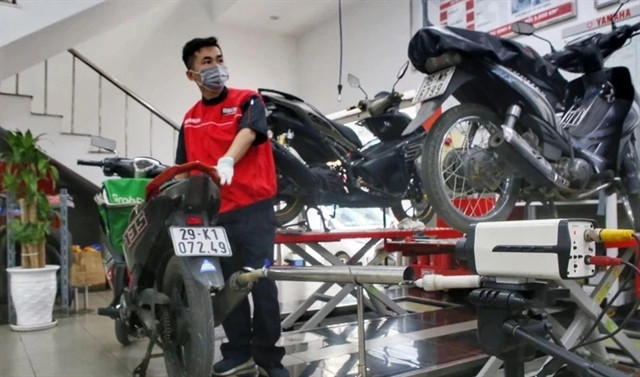 |
| An employee measures exhaust emissions at a motorbike maintenance and repair facility. VNA/VNS Photo Tuấn Đức |
Currently, in Việt Nam there is no regulation on the shelf life of personal motorbikes, so controlling motorbike emissions is necessary to minimise environmental pollution.
In order to reduce emissions and environmental pollution, implementing Việt Nam's commitments at COP26, there will need to be emission inspections from the start of 2025.
Many traffic experts insist that while this is absolutely necessary, it needs to be done in such a way that it will not have too much impact on traffic and people's lives.
According to the provisions of the Law on Road Traffic Order and Safety recently passed by the National Assembly, motorcycles and mopeds will have to undergo mandatory emissions testing from January 1, 2025.
The law also stipulates that emissions inspection shall be carried out in accordance with the law on environmental protection and must be carried out at emission inspection facilities that meet national technical regulations and be issued inspection certificate by the register agency.
According to data from the Institute of Transport Strategy and Development (Ministry of Transport), in the period 2005-2022, motorbike growth in the country averaged about 9.1 per cent a year.
To date, the number of registered motorbikes nationwide has reached about 69.2 million and the number of vehicles in circulation has reached about 45.5 million.
In big cities, motorbikes are still the main means of transport, meaning they are responsible for the largest emissions into the environment.
According to results from three emission testing programmes for motorbikes and mopeds in three cities of Hà Nội, HCM City and Đà Nẵng City, vehicles over five years old tend to exceed current emission standards and vehicles which are older than ten years, have a very large emission rate.
But in all three cities, those older vehicles make up over half of the total number of motorbikes in use.
Specifically, the rate is 72.58 per cent, 68 per cent and 59 per cent in Hà Nội, HCM City and Đà Nẵng City, respectively.
Nguyễn Xuân Thủy, former director of Transport Publishing House said that that emissions testing not only helps reduce environmental pollution, improve quality of life, but also raises people's awareness in periodically maintaining vehicles to ensure traffic safety.
According to Khương Kim Tạo, former Deputy Chief of Office of the National Traffic Safety Committee, currently in Việt Nam, there is no regulation on the shelf life of motorbikes. Expiry date regulations only apply to trucks, passenger cars or taxis.
“Emission control for motorbikes was regulated in the 2008 Road Traffic Law, but the implementation process encountered many difficulties,” Tạo said.
“And up to now, continued implementation is completely accurate, urgent and an inevitable trend of controlling motor vehicle emissions in big cities like Hà Nội and HCM City. This must be done as quickly as possible to ensure commitments to control emissions and environmental pollution that Việt Nam participated in at the COP26."
However, Tạo also noted that the implementation method needs to be methodically researched, without disturbing people's lives, socio-economic development while still controlling motorbike emissions.
Regulation on threshold of exhaust gas emission
Tạo proposed a methodical implementation of the news rules, with the understanding that newly manufactured and assembled motorbikes imported to Việt Nam already meet emissions regulations and standards.
New vehicles will gradually replace old ones but there needs to be a certain period of time to eliminate 'out of date' vehicles.
“When there are enough economic resources, a time limit will be set for liquidation of this vehicle line which will no longer be allowed to be driven in big cities,” Tạo said.
“The emission problem will be solved through administrative control and changing a large number of vehicles,” he added.
To quickly promote emission control for motorbikes in circulation, Tạo suggested that the State management agency should research and regulate the level of emission quality for motorbikes in use in order to control exhausted gas emission.
In addition, motorbike emission inspection centres should provide solutions, so as not to affect people waiting for vehicle inspection, he added. VNS